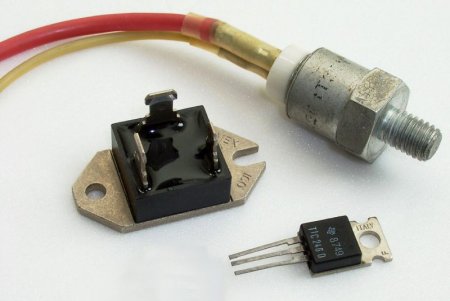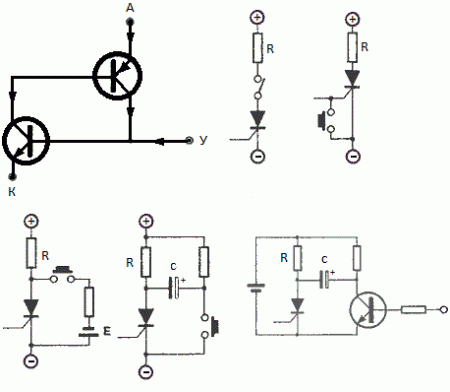How does a triac differ from a thyristor
A thyristor is a controlled semiconductor switch that has unidirectional conduction. In the open state, it behaves like a diode and the principle of control of a thyristor differs from a transistor, although both have three terminals and have the ability to amplify the current.
Thyristor outputs Is anode, cathode and control electrode.
Anode and cathode — these are the electrodes of a vacuum tube or semiconductor diode. It is better to remember them by the image of the diode on the circuit diagrams. Imagine that the electrons leave the cathode in a diverging beam in the shape of a triangle and reach the anode, then the exit from the top of the triangle is the negatively charged cathode and the opposite exit is the positively charged anode.
By applying a certain voltage to the control electrode relative to the cathode, the thyristor can be switched into a conducting state. And to close the thyristor again, it is necessary to make its operating current less than the holding current of the given thyristor.
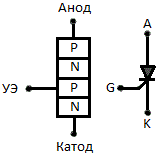
The thyristor as a semiconductor electronic component consists of four semiconductor (silicon) layers p and n. In the figure, the upper terminal is the anode - the p-type region, the lower terminal is the cathode - the n-type region, the control electrode is led out from the side - the p-type region. The negative terminal of the power supply is connected to the cathode, and the load is connected to the anode circuit, whose power must be controlled.
Acting on the control electrode with a signal of a certain duration, it is very easy to control the load in the AC circuit by unlocking the thyristor in a certain phase of the period of the grid sinusoid, then the thyristor will close automatically when the sinusoidal current crosses zero. This is a simple and very popular way to regulate the power of an active load.

According to the internal structure of the thyristor, in the closed state, it can be represented as a chain of three diodes connected in series, as shown in the figure. It can be seen that in the closed state this circuit will not pass current in either direction. We now present the thyristor as an equivalent circuit of transistors.
It can be seen that sufficient base current of the lower n-p-n transistor will cause its collector current to increase, which immediately becomes the base current of the upper p-n-p transistor.
The topmost pnp transistor is now turned on and its collector current is added to the base current of the bottom transistor and it is held open due to the positive feedback in this circuit. And if you stop applying voltage to the control electrode now, the open state will remain so.
In order to lock this circuit, you will need to somehow interrupt the common collector current of these transistors. The different shutdown methods (mechanical and electronic) are shown in the figure.
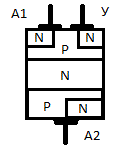
Triac, unlike the thyristor, has six layers of silicon and in the conductive state it conducts current not in one but in both directions, like a closed switch. According to the equivalent circuit, it can be represented as two thyristors connected in parallel, only the control electrode remains one common to two. And after opening the triac to close, the voltage polarity of the operating terminals must be reversed or the operating current must become less than the holding current of the triac.
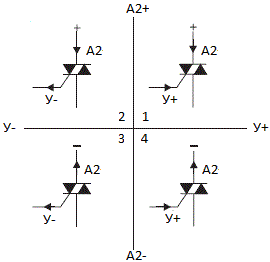
If the triac is installed to control power to a load in an AC or DC circuit, then depending on the polarity of the current and the direction of the gate current, certain control methods will be preferred for each situation. All possible combinations of polarities (of the control electrode and in the working circuit) can be represented in the form of four quadrants.
It is worth noting that quadrants 1 and 3 correspond to the usual schemes for controlling the power of an active load in AC circuits, when the polarities of the control electrode and the electrode A2 coincide in each half-cycle, in such situations the control electrode of the triac is quite sensitive.
See also on this topic:Principles of thyristor and triac control

